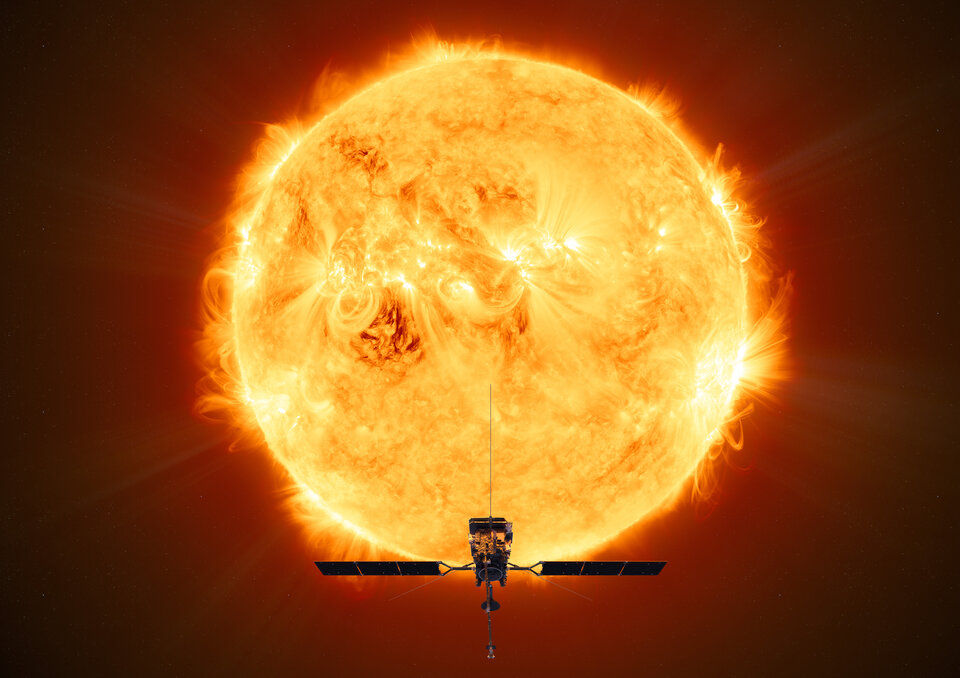On April 10th, ESA’s Solar Orbiter made its closest flyby of the Sun, coming to within just 29% of the distance from the Earth to the Sun. From this vantage point, the spacecraft is performing close-up studies of our Sun and inner heliosphere. This is basically uncharted territory, as we’ve never had a spacecraft this close to the Sun.
One of the goals of the mission is to figure out why the Sun’s corona — its outer atmosphere — is so hot. The corona can reach temperatures of 2 million degrees C, vastly hotter than its 5,500 C surface. A new paper based on Solar Orbiter data, may offer some clues.
Last year, the spacecraft returned data showing that a known phenomenon called magnetic reconnection is taking place on the Sun’s surface. But in this case, it is taking place on extremely small scales, which previously were not able to be seen.
In the team’s paper, published in the journal Nature, they explain that magnetic reconnection occurs when a magnetic field changes itself into a more stable configuration. It is a fundamental energy release mechanism in superheated gasses known as plasmas. These reconnections have been seen previously occurring over large areas of the Sun’s surface and are known to be a key mechanism involved in causing solar flares and eruptions.
The new research, which combined data from Solar Orbiter along with NASA’s Solar Dynamics Observatory (SDO) and the Interface Region Imaging Spectrograph (IRIS) missions, shows that the magnetic reconnection occurring at smaller scales is a prime candidate for the mysterious heating of the Sun’s corona.
“Taking advantage of extreme-ultraviolet (EUV) imaging data from the High-resolution Coronal Imager (Hi-C), which ideally is able to resolve scales on the order of 150?km, provided evidence for reconnection between braided magnetic threads and corresponding heating,” the team wrote in their paper. They said the observations, which took place on March 2, 2022 took place over the period of one hour.
In an ESA press release, the team said Solar Orbiter’s ultra-high-resolution observations shows persistent small-scale (around 390 km across) reconnections take place in the corona. These are revealed to be a long-lived ‘gentle’ sequence compared to sudden explosive releases of energy that reconnection is usually associated with for events like coronal mass ejections.
The researchers said the temperatures around the point of the magnetic field where the magnetic field intensity drops to zero, known as the null-point, sustained itself at around 10 million °C, and generated an outflow of material that came in the form of discrete ‘blobs’ travelling away from the null point with a speed of around 80 km/s.

In addition to this continuous outflow, an explosive episode also took place around this null point, and lasted for four minutes.
The team said that Solar Orbiter’s results suggest that magnetic reconnection, at scales that were previously too small to be resolved, proceeds continually in both gentle and explosive ways. This is importantly because it means that reconnection can therefore persistently transfer mass and energy to the overlying corona, contributing to heating it.
As the Solar Orbiter mission continues, the researchers said they now hope perform observations at even higher spatio-temporal resolution in future close approaches by the spacecraft to estimate what fraction of the corona’s heat may be transferred in this way.
The spacecraft is in a 180 day-long orbit around the Sun, where it reaches closest approach to the Sun every six months, at around 42 million km (26 million miles) from the Sun.
Further reading:
Paper published in Nature
ESA press release


“This is basically uncharted territory, as we’ve never had a spacecraft this close to the Sun.” Nancy, what about the Parker Solar Probe? Are you saying Solar Orbiter will eventually get closer to the Sun than Parker Solar Probe did? See https://www.esa.int/Science_Exploration/Space_Science/Solar_Orbiter/Teamwork_with_Parker_Solar_Probe for ESA’s discussion of the partnership between these spacecraft.
This is encouraging news! Magnetic reconnection has long been a prime suspect for the solar corona high temperature, and now it is observed generating higher temperatures.
Spellucci, thanks for the nice reference! I suspect that a single word may have been lost, i.e. from “as we’ve never had a spacecraft this close to the Sun” to “as we’ve never had an imaging spacecraft this close to the Sun.” Re “However, Parker Solar Probe has no cameras that view the Sun directly. No current technology could look at the Sun from that close a distance and survive. This is where Solar Orbiter comes in.”